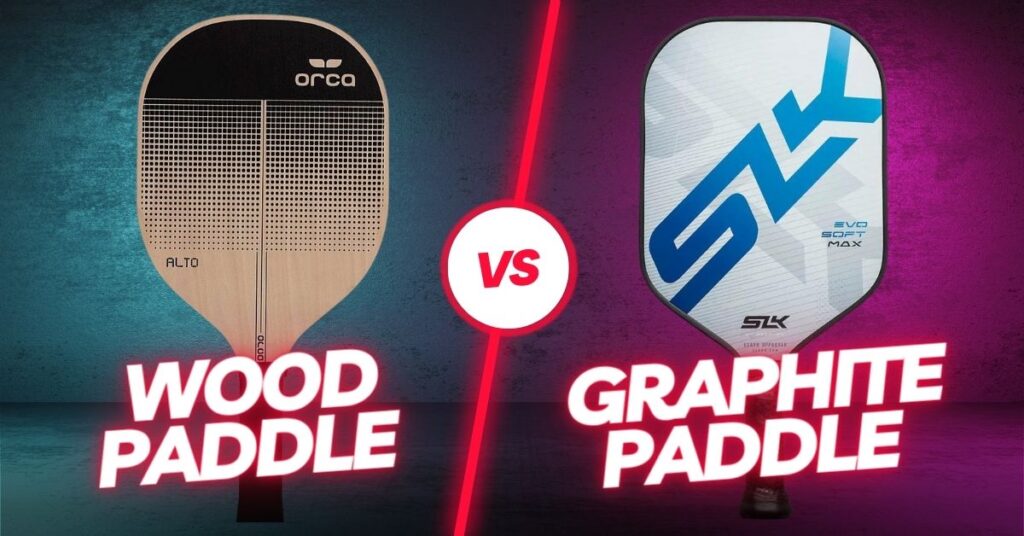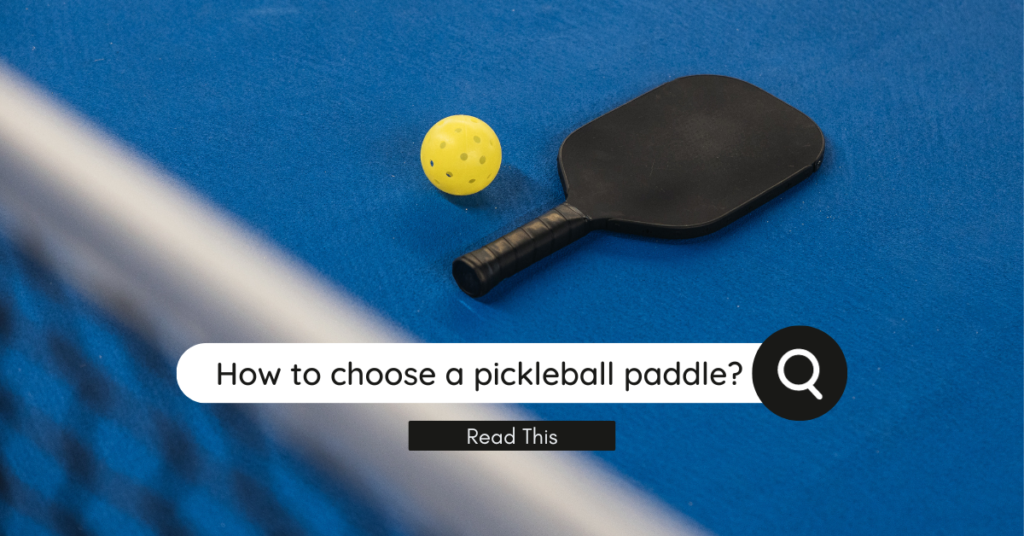Wood and graphite pickleball paddles have different qualities and properties that affect gameplay.
Picture this: you’re on the pickleball court, paddle in hand, and faced with a choice – wood or graphite? It’s not just a decision; it’s a pivotal moment that can shape your game. In the ultimate showdown of pickleball paddles, let’s break down the basics in a way that’s as friendly as a chat over coffee. So, whether you’re a seasoned player or just starting out, let’s navigate the delightful world of Wood vs. Graphite paddles and find your ideal match!
Wood Pickleball Paddles
Wood pickleball paddles have been around since the game’s inception and continue to be a popular choice for many players. While other materials such as graphite and composite have gained traction in recent years, wood paddles still hold their own in the pickleball community. In this section, we will explore the characteristics, pros, and cons of wood paddles to help you make an informed decision when choosing a pickleball paddle.
Characteristics Of Wood Paddles
Wood paddles have a unique set of characteristics that set them apart from other paddle materials. Here are some notable features of wood paddles:
- Traditional Feel: Wood paddles provide a classic and authentic feel that some players prefer over modern materials. The solid wood construction gives these paddles a nostalgic touch that harkens back to the origins of the sport.
- Sturdy and Durable: Wood paddles are known for their durability and long lifespan. The solid wood construction makes them resilient to wear and tear, making them a reliable choice for players who want a paddle that will last.
- Natural Power and Control: Wood paddles offer a good blend of power and control. The natural density of wood allows players to generate power in their shots while maintaining a level of control over the ball.
- Pleasant Sound: One distinct characteristic of wood paddles is the satisfying “thwack” sound they produce when hitting the ball. This auditory feedback adds to the overall playing experience for many players.
Credit: www.walmart.com
Pros And Cons Of Wood Paddles
Like any paddle material, wood paddles have their advantages and disadvantages. Let’s take a closer look:
Pros:
- Cost-effective: Wood paddles are generally more affordable compared to graphite and composite paddles, making them a budget-friendly option for players.
- Classic Style: If you prefer a paddle with a traditional look and feel, wood paddles are the way to go. They embody the essence of pickleball’s heritage and add a touch of nostalgia to your game.
- Durability: Wood paddles are known for their longevity, making them a great investment for players who want a paddle that can withstand regular use.
Cons:
- Weight: Wood paddles tend to be slightly heavier compared to graphite and composite paddles. This additional weight can be a disadvantage for players who prefer a lightweight paddle.
- Limited Technology: Unlike graphite and composite paddles, wood paddles do not benefit from the advanced technologies and design innovations that enhance performance. They may not offer the same level of power, control, and spin as their modern counterparts.
- Varied Quality: Wood paddles can vary in quality depending on the craftsmanship and type of wood used. It’s essential to choose a high-quality wood paddle to ensure optimal performance.
Graphite Pickleball Paddles
When it comes to choosing the right pickleball paddle, there are a few options to consider. One popular choice among players is the graphite pickleball paddle. These paddles are known for their durability, lightweight design, and responsive performance. In this section, we will explore the characteristics, pros, and cons of graphite paddles to help you make an informed decision.
Characteristics Of Graphite Paddles
Graphite pickleball paddles are made using a combination of graphite and other composite materials. This blend creates a lightweight paddle that offers excellent maneuverability and control. Here are some key characteristics of graphite paddles:
- Lightweight: Graphite paddles are significantly lighter than their wooden counterparts, allowing players to swing and react more swiftly on the court. The lighter weight also reduces fatigue during extended play sessions.
- Durable: Graphite paddles are known for their durability, making them a long-lasting investment. The composite materials used in their construction are resistant to dings, dents, and scratches, ensuring the paddle remains in good condition over time.
- Responsive: Graphite paddles provide a high level of responsiveness, allowing players to feel each shot and adjust their technique accordingly. This responsiveness enhances control and accuracy on the court, making graphite paddles ideal for players who prioritize precision.
Pros And Cons Of Graphite Paddles
Like any equipment, graphite pickleball paddles have their own set of pros and cons. It’s important to consider these factors before making your purchase decision. Let’s take a closer look:
| Pros | Cons |
| Lightweight design for increased maneuverability | Relatively higher cost compared to wooden paddles |
| Durable construction for long-lasting performance | Somewhat less power compared to wooden paddles |
| Responsive surface for enhanced control and accuracy | Less “feel” compared to wooden paddles for some players |
Overall, graphite pickleball paddles offer numerous advantages with their lightweight design, durability, and responsiveness. However, they may come at a slightly higher cost and provide slightly less power compared to wooden paddles. Additionally, some players may prefer the unique “feel” of wooden paddles over graphite. Consider your playing style and preferences when deciding which paddle material suits you best.
Comparing Performance
When it comes to choosing a pickleball paddle, the material used in its construction plays a vital role in determining its performance on the court. Wood and graphite are two popular choices, each offering unique characteristics that can enhance your game. In this article, we will compare the performance of wood and graphite pickleball paddles, focusing on two key aspects: power and control, as well as durability and weight.
Power And Control
Power and control are two crucial factors that can significantly impact your performance in the game of pickleball. Wood and graphite paddles differ in how they handle power and control, allowing players to choose the option that aligns with their playing style.
Wood Paddles:
Wood paddles are known for their superior power capabilities. Made from solid wood, these paddles tend to provide a harder surface, resulting in increased power when striking the ball. This makes wood paddles a preferred choice for players who rely on powerful shots and aggressive playstyles.
Graphite Paddles:
On the other hand, graphite paddles are renowned for their exceptional control. The lightweight nature of graphite allows players to maneuver the paddle with ease, providing precise shots and better ball placement. This control-oriented characteristic of graphite paddles is highly favored by players who prioritize finesse and accuracy in their game.
Durability And Weight
When it comes to durability and weight, wood and graphite paddles have their own advantages and considerations that players should take into account.
Wood Paddles:
Wood paddles are renowned for their durability. Crafted from solid hardwood, these paddles are known to withstand heavy usage over extended periods. They are less prone to cracking or breaking, making them an excellent choice for players looking for long-lasting equipment that can withstand constant wear and tear. However, it is important to note that wood paddles tend to be heavier compared to graphite paddles.
Graphite Paddles:
Graphite paddles, being lightweight in nature, offer players greater maneuverability and reduced strain during extended play. The lightweight design allows for quicker reactions, making them a popular choice for fast-paced gameplay. However, it is important to note that graphite paddles are more susceptible to scratches and dings, which may affect their longevity.
Ultimately, the choice between wood and graphite pickleball paddles depends on your individual playing style and personal preferences. Take into consideration the power and control needed for your game, as well as the desired durability and weight of your paddle. By understanding the differences between these two materials, you can make an informed decision that will enhance your performance on the pickleball court.
Frequently Asked Questions Of Wood Vs Graphite Pickleball Paddles
Q: Which Type Of Pickleball Paddle Is Better – Wood Or Graphite?
A: Both wood and graphite paddles offer unique advantages, so the better choice depends on your playing style, preferences, and skill level.
Q: What Are The Benefits Of Using A Wood Pickleball Paddle?
A: Wood paddles provide excellent control, comfort, and a traditional feel, making them ideal for beginners and players who value touch and finesse.
Q: Why Should I Consider Using A Graphite Pickleball Paddle Instead?
A: Graphite paddles are known for their lightweight, maneuverability, and power, making them a popular choice for advanced players seeking greater speed and agility.
Q: Are Wood Paddles More Durable Than Graphite Ones?
A: While wood paddles may be more prone to scratches and dents, they can withstand heavy impacts better than graphite paddles, which can occasionally crack.
Q: Can I Switch Between Wood And Graphite Paddles During A Game?
A: Absolutely! As long as you’re comfortable with the different characteristics, you can switch between wood and graphite paddles without any restrictions.
Conclusion
Ultimately, choosing between wood and graphite pickleball paddles boils down to personal preference and playing style. Both options have their pros and cons, with wood offering a traditional feel and enhanced touch, while graphite provides increased power and maneuverability. Consider your playing needs and goals, experiment with both paddle materials, and select the one that best suits your game.
Happy pickleball playing!



